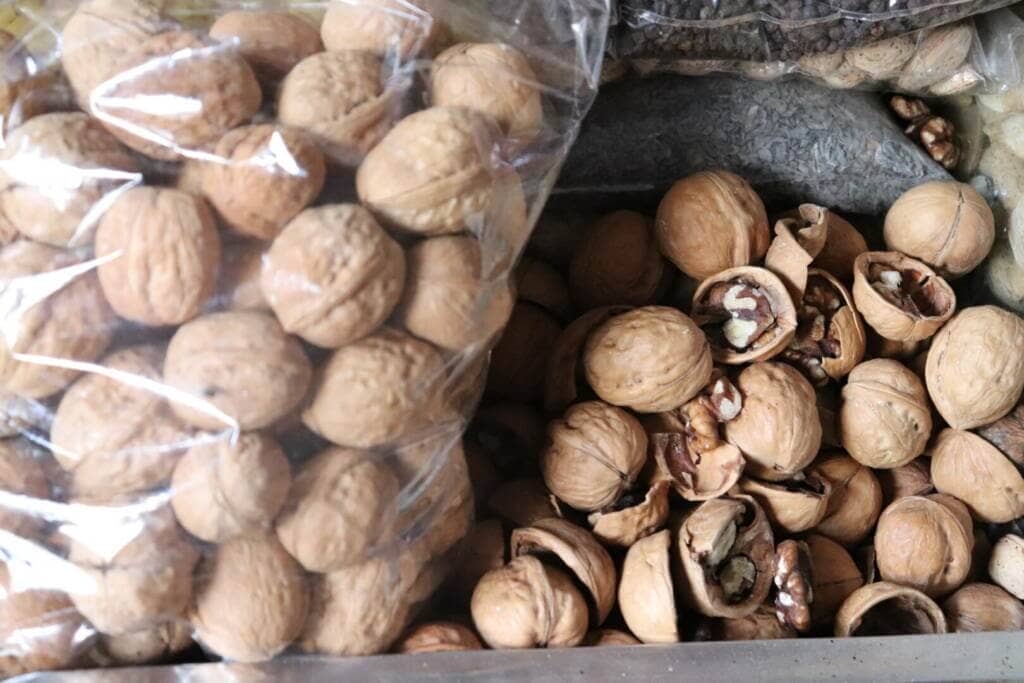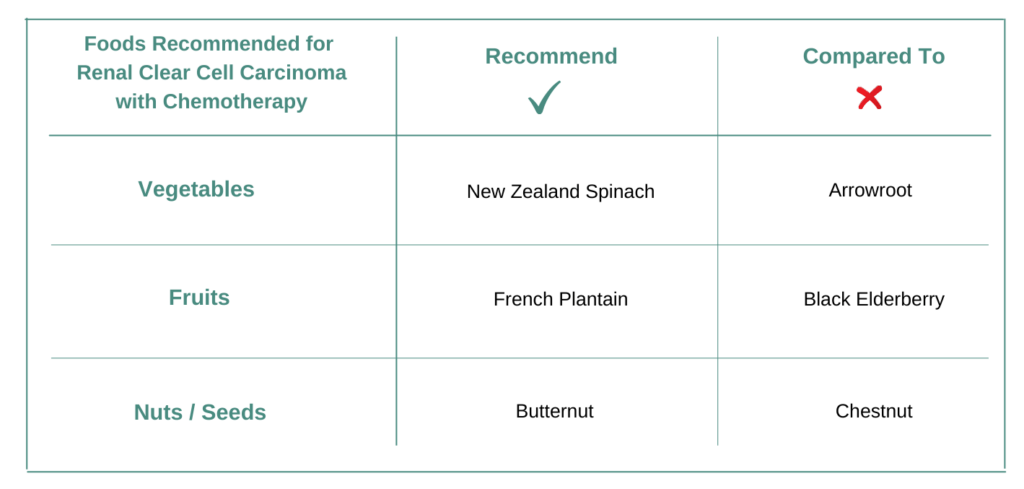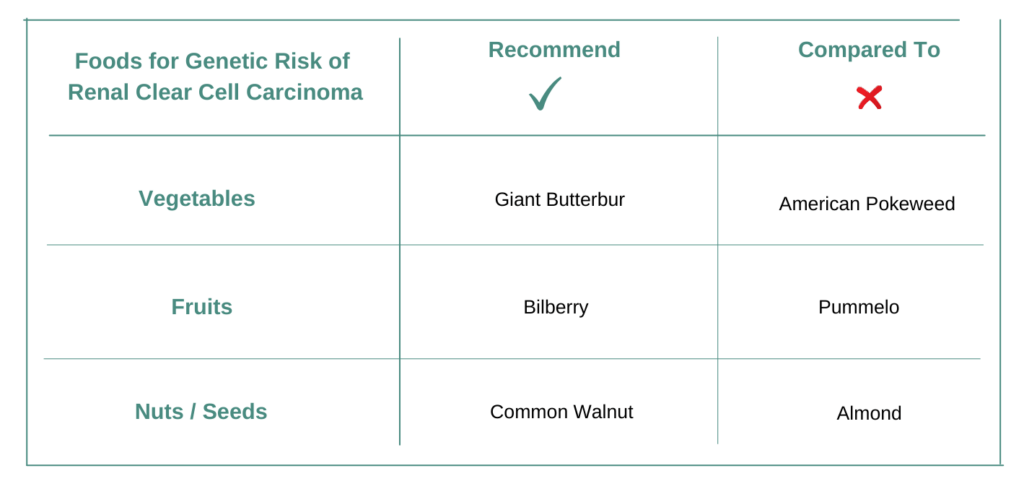Introduction
Foods for Renal Clear Cell Carcinoma should be personalized for each individual and also must adapt when cancer treatment or tumor genetic change. The personalization and adaptation must consider all the active ingredients or bioactives contained in different foods with respect to cancer tissue biology, genetics, treatments, lifestyle conditions and diet preferences. Hence while nutrition is one of the very important decisions for a cancer patient and individual at risk of cancer to make – how to choose foods to eat is not an easy task.
Clear cell renal cell carcinoma (RCC) is the most common type of kidney cancer, characterized by malignant cells with clear cytoplasm. Pathology outlines play a crucial role in understanding the characteristics and features of clear cell RCC for accurate diagnosis. Although clear cell RCC is the most prevalent subtype, non-clear cell RCC can also occur. The prognosis for clear cell RCC may vary depending on various factors, including stage, grade, and the patient’s overall health. Treatment options for clear cell RCC involve a multidisciplinary approach, including surgery, targeted therapy, immunotherapy, and radiation therapy, tailored to each individual case. Radiology techniques assist in visualizing and evaluating clear cell RCC tumors. Accurate coding using the ICD-10 system ensures proper documentation of clear cell RCC in medical records. Survival rates for clear cell RCC depend on the stage and response to treatment. Genetic alterations are associated with the development of clear cell RCC and ongoing research aims to improve understanding and targeted therapies. Early detection and proper staging contribute to better outcomes for patients. Symptoms of clear cell RCC may include blood in urine, back pain, weight loss, and fatigue. Raising awareness of clear cell RCC can aid in timely diagnosis and prompt treatment initiation. Understanding the difference between clear cell and non-clear cell RCC is important for appropriate management approaches. With advancements in treatment options and surveillance, prognosis and survival rates for clear cell RCC continue to improve.
For Renal Clear Cell Carcinoma does it matter what vegetables, fruits, nuts, seeds one eats?
A very common nutrition question asked by cancer patients and individuals at-genetic risk of cancer is – for cancers like Renal Clear Cell Carcinoma does it matter what foods I eat and which I do not? Or if I follow a plant-based diet is that enough for cancer like Renal Clear Cell Carcinoma?
For example does it matter if vegetable New Zealand Spinach is consumed more compared to Arrowroot? Does it make any difference if fruit Black Elderberry is preferred over French Plantain? Also if similar choices are made for nuts/seeds like Butternut over Chestnut and for pulses like Broad Bean over Yardlong Bean. And if what I eat matters – then how does one identify foods which are recommended for Renal Clear Cell Carcinoma and is it the same answer for everyone with the same diagnosis or genetic risk?
Yes! Foods you eat matters for Renal Clear Cell Carcinoma!
Food recommendations may not be the same for everyone and can be different even for the same diagnosis and genetic risk.

All foods (vegetables, fruits, nuts, seeds, pulses, oils etc.) and nutritional supplements are made up of more than one active molecular ingredient or bio-actives in different proportions and quantities. Each active ingredient has a unique mechanism of action – which can be activation or inhibition of different biochemical pathways. Simply stated foods and supplements which are recommended are those which do not cause an increase of molecular drivers of cancer but reduce them. Else those foods should not be recommended. Foods contain multiple active ingredients – hence when evaluating foods and supplements you need to consider the impact of all active ingredients cumulatively rather than individually.
For example Black Elderberry contains active ingredients Quercetin, Curcumin, Apigenin, Myricetin, Isoliquiritigenin. And French Plantain contains active ingredients Quercetin, Curcumin, Apigenin, Myricetin, Isoliquiritigenin and possibly others.
A common mistake made when deciding and choosing foods to eat for Renal Clear Cell Carcinoma – is to evaluate only selected active ingredients contained in foods and ignore the rest. Because different active ingredients contained in foods may have opposing effects on cancer drivers – you cannot cherry pick active ingredients in foods and supplements for making a nutrition decision for Renal Clear Cell Carcinoma.
YES – FOOD CHOICES MATTER FOR CANCER. NUTRITION DECISIONS MUST CONSIDER ALL ACTIVE INGREDIENTS OF FOODS.
Skills Needed for Nutrition Personalization for Renal Clear Cell Carcinoma?
Personalized nutrition for cancers like Renal Clear Cell Carcinoma consists of recommended foods / supplements; not recommended foods / supplements with example recipes which prioritize use of recommended foods. An example of personalized nutrition can be seen at this link.
Deciding which foods are recommended or not is extremely complicated, requiring expertise in Renal Clear Cell Carcinoma biology, food science, genetics, biochemistry along with good understanding of how cancer treatments work and associated vulnerabilities by which the treatments could stop being effective.
MINIMUM KNOWLEDGE EXPERTISE NEEDED FOR NUTRITION PERSONALIZATION FOR CANCER ARE: CANCER BIOLOGY, FOOD SCIENCE, CANCER TREATMENTS AND GENETICS.
Foods to Eat After Cancer Diagnosis!
No two cancers are the same. Go beyond the common nutrition guidelines for everyone and make personalized decisions about food and supplements with confidence.
Characteristics of cancers like Renal Clear Cell Carcinoma
All cancers like Renal Clear Cell Carcinoma can be characterized by a unique set of biochemical pathways – the signature pathways. Biochemical pathways like MAPK Signaling, RAS-RAF Signaling, PI3K-AKT-MTOR Signaling, Small Molecule Transport are part of the signature definition of Renal Clear Cell Carcinoma. Each individual’s cancer genetics can be different and hence their specific cancer signature could be unique.
The treatments which are effective for Renal Clear Cell Carcinoma need to be cognizant of the associated signature biochemical pathways for each cancer patient and individual at genetic risk. Therefore different treatments with different mechanisms of actions are effective for different patients. Similarly and for the same reasons foods and supplements need to be personalized for each individual. Hence some foods and supplements are recommended for Renal Clear Cell Carcinoma when taking cancer treatment Sorafenib, and some foods and supplements are not recommended.
Sources like cBioPortal and many others provide population representative patient anonymized data from clinical trials for all cancer indications. This data consists of clinical trial study details like sample size / number of patients, age groups, gender, ethnicity, treatments, tumor site and any genetic mutations.
VHL, PBRM1, MUC16, SETD2 and PRKDC are the top ranked reported genes for Renal Clear Cell Carcinoma. VHL is reported in 2.6 % of the representative patients across all clinical trials. And PBRM1 is reported in 1.8 %. The combined population patient data cover ages from 21 to 91. 69.8 % of the patient data are identified as men. The Renal Clear Cell Carcinoma biology along with reported genetics together define the population represented signature biochemical pathways for this cancer. If the individual cancer tumor genetics or genes contributing to the risk are also known then that should also be used for nutrition personalization.
NUTRITION CHOICES SHOULD MATCH WITH EACH INDIVIDUAL’S CANCER SIGNATURE.
Food and Supplements for Renal Clear Cell Carcinoma
For Cancer Patients
Cancer patients on treatment or on palliative care need to make decisions on food and supplements – for the needed dietary calories, for managing any treatment side effects and also for improved cancer management. All plant-based foods are not equal and choosing and prioritizing foods which are personalized and customized to ongoing cancer treatment is important and complicated. Here are some examples providing guidelines for making nutrition decisions.
Choose Vegetable NEW ZEALAND SPINACH or ARROWROOT?
Vegetable New Zealand Spinach contains many active ingredients or bioactives such as Quercetin, Curcumin, Apigenin, Myricetin, Isoliquiritigenin. These active ingredients manipulate various biochemical pathways like DNA Repair, Cell Cycle, MAPK Signaling and Microtubule Dynamics and others. New Zealand Spinach is recommended for Renal Clear Cell Carcinoma when ongoing cancer treatment is Sorafenib. This is because New Zealand Spinach modifies those biochemical pathways which have been scientifically reported to sensitize the effect of Sorafenib.
Some of the active ingredients or bioactives in vegetable Arrowroot are Quercetin, Curcumin, Apigenin, Myricetin, Isoliquiritigenin. These active ingredients manipulate various biochemical pathways like Oncogenic Histone Methylation, Oxidative Stress and PI3K-AKT-MTOR Signaling and others. Arrowroot is not recommended for Renal Clear Cell Carcinoma when ongoing cancer treatment is Sorafenib because it modifies those biochemical pathways which make the cancer treatment resistant or less responsive.
VEGETABLE NEW ZEALAND SPINACH IS RECOMMENDED OVER ARROWROOT FOR Renal Clear Cell Carcinoma AND TREATMENT Sorafenib.
Choose Fruit FRENCH PLANTAIN or BLACK ELDERBERRY?
Fruit French Plantain contains many active ingredients or bioactives such as Quercetin, Curcumin, Apigenin, Myricetin, Isoliquiritigenin. These active ingredients manipulate various biochemical pathways like DNA Repair, Cell Cycle, MAPK Signaling and Microtubule Dynamics and others. French Plantain is recommended for Renal Clear Cell Carcinoma when ongoing cancer treatment is Sorafenib. This is because French Plantain modifies those biochemical pathways which have been scientifically reported to sensitize the effect of Sorafenib.
Some of the active ingredients or bioactives in fruit Black Elderberry are Quercetin, Curcumin, Apigenin, Myricetin, Isoliquiritigenin. These active ingredients manipulate various biochemical pathways like Oncogenic Histone Methylation, Oxidative Stress and PI3K-AKT-MTOR Signaling and others. Black Elderberry is not recommended for Renal Clear Cell Carcinoma when ongoing cancer treatment is Sorafenib because it modifies those biochemical pathways which make the cancer treatment resistant or less responsive.
FRUIT FRENCH PLANTAIN IS RECOMMENDED OVER BLACK ELDERBERRY FOR Renal Clear Cell Carcinoma AND TREATMENT Sorafenib.
Choose Nut BUTTERNUT or CHESTNUT?
Butternut contains many active ingredients or bioactives such as Curcumin, Apigenin, Myricetin, Isoliquiritigenin, Lupeol. These active ingredients manipulate various biochemical pathways like DNA Repair, Cell Cycle, MAPK Signaling and Microtubule Dynamics and others. Butternut is recommended for Renal Clear Cell Carcinoma when ongoing cancer treatment is Sorafenib. This is because Butternut modifies those biochemical pathways which have been scientifically reported to sensitize the effect of Sorafenib.
Some of the active ingredients or bioactives in Chestnut are Ellagic Acid, Curcumin, Apigenin, Myricetin, Isoliquiritigenin. These active ingredients manipulate various biochemical pathways like DNA Repair, Epithelial to Mesenchymal Transition, WNT Beta Catenin Signaling and Oxidative Stress and others. Chestnut is not recommended for Renal Clear Cell Carcinoma when ongoing cancer treatment is Sorafenib because it modifies those biochemical pathways which make the cancer treatment resistant or less responsive.
BUTTERNUT IS RECOMMENDED OVER CHESTNUT FOR Renal Clear Cell Carcinoma AND TREATMENT Sorafenib.

For Individuals with Genetic Risk of Cancer
The question asked by individuals who have genetic risk of Renal Clear Cell Carcinoma or familial history is “What Should I Eat Differently from Before?” and how they should choose foods and supplements to manage risks of the disease. Since for cancer risk there is nothing actionable in terms of treatment – decisions of foods and supplements become important and one of the very few actionable things which can be done. All plant-based foods are not equal and based on identified genetics and pathway signature – the choices of food and supplements should be personalized.
Choose Vegetable GIANT BUTTERBUR or AMERICAN POKEWEED?
Vegetable Giant Butterbur contains many active ingredients or bioactives such as Apigenin, Curcumin, Daidzein, Lupeol, Catechol. These active ingredients manipulate various biochemical pathways like Hypoxia, P53 Signaling, Angiogenesis and Cell Cycle Checkpoints and others. Giant Butterbur is recommended for risk of Renal Clear Cell Carcinoma when associated genetic risk is MUC16. This is because Giant Butterbur increases those biochemical pathways which counteract the signature drivers of it.
Some of the active ingredients or bioactives in vegetable American Pokeweed are Apigenin, Curcumin, Quercetin, Daidzein, Lupeol. These active ingredients manipulate various biochemical pathways like DNA Repair and Hypoxia and others. American Pokeweed is not recommended when risk of Renal Clear Cell Carcinoma when associated genetic risk is MUC16 because it increases the signature pathways of it.
VEGETABLE GIANT BUTTERBUR IS RECOMMENDED OVER AMERICAN POKEWEED FOR MUC16 GENETIC RISK OF CANCER.
Choose Fruit BILBERRY or PUMMELO?
Fruit Bilberry contains many active ingredients or bioactives such as Apigenin, Curcumin, Resveratrol, Quercetin, Daidzein. These active ingredients manipulate various biochemical pathways like DNA Repair, Hypoxia, P53 Signaling and Angiogenesis and others. Bilberry is recommended for risk of Renal Clear Cell Carcinoma when associated genetic risk is MUC16. This is because Bilberry increases those biochemical pathways which counteract the signature drivers of it.
Some of the active ingredients or bioactives in fruit Pummelo are Apigenin, Curcumin, Quercetin, Daidzein, Lupeol. These active ingredients manipulate various biochemical pathways like Hypoxia and Extracellular Matrix Remodelling and others. Pummelo is not recommended when risk of Renal Clear Cell Carcinoma when associated genetic risk is MUC16 because it increases the signature pathways of it.
FRUIT BILBERRY IS RECOMMENDED OVER PUMMELO FOR MUC16 GENETIC RISK OF CANCER.
Choose Nut COMMON WALNUT or ALMOND?
Common Walnut contains many active ingredients or bioactives such as Curcumin, Quercetin, Ellagic Acid, Daidzein, Lupeol. These active ingredients manipulate various biochemical pathways like Hypoxia, P53 Signaling, Angiogenesis and Cell Cycle Checkpoints and others. Common Walnut is recommended for risk of Renal Clear Cell Carcinoma when associated genetic risk is MUC16. This is because Common Walnut increases those biochemical pathways which counteract the signature drivers of it.
Some of the active ingredients or bioactives in Almond are Curcumin, Daidzein, Lupeol, Catechol, Formononetin. These active ingredients manipulate various biochemical pathways like DNA Repair and Angiogenesis and others. Almond is not recommended when risk of Renal Clear Cell Carcinoma when associated genetic risk is MUC16 because it increases the signature pathways of it.
COMMON WALNUT IS RECOMMENDED OVER ALMOND FOR MUC16 GENETIC RISK OF CANCER.

In Conclusion
Foods and Supplements chosen are important decisions for cancers like Renal Clear Cell Carcinoma. Renal Clear Cell Carcinoma patients and individuals with genetic-risk always have this question: “What foods and nutritional supplements are recommended for me and which are not?” There is a common belief which is a misconception that all plant-based foods could be beneficial or not but would not be harmful. Certain foods and supplements can interfere with cancer treatments or promote molecular pathway drivers of cancer.
There are different types of cancer indications like Renal Clear Cell Carcinoma, each with different tumor genetics with further genomic variations across each individual. Further every cancer treatment and chemotherapy has a unique mechanism of action. Each food like New Zealand Spinach contains various bioactives in different quantities, which have an impact on different and distinct sets of biochemical pathways. The definition of personalized nutrition is individualized food recommendations for the cancer indication, treatments, genetics, lifestyle and other factors. Nutrition personalization decisions for cancer require knowledge of cancer biology, food science and an understanding of different chemotherapy treatments. Finally when there are treatment changes or new genomics is identified – the nutrition personalization needs re-evaluation.
The addon nutrition personalization solution makes the decision making easy and removes all the guesswork in answering the question, “What foods should I choose or not choose for Renal Clear Cell Carcinoma?”. The addon multi-disciplinary team includes cancer physicians, clinical scientists, software engineers and data scientists.
Personalized Nutrition for Cancer!
Cancer changes with time. Customize and modify your nutrition based on cancer indication, treatments, lifestyle, food preferences, allergies and other factors.
References
- Tmb Mskcc 2018
- Pan-cancer analysis of whole genomes.
- Gallic acid provokes DNA damage and suppresses DNA repair gene expression in human prostate cancer PC-3 cells.
- Dietary D-glucarate effects on the biomarkers of inflammation during early post-initiation stages of benzo[a]pyrene-induced lung tumorigenesis in A/J mice.
- Research progress on the anticancer effects of vitamin K2.
- β-Carotene-induced apoptosis is mediated with loss of Ku proteins in gastric cancer AGS cells.
- Daidzein effect on hormone refractory prostate cancer in vitro and in vivo compared to genistein and soy extract: potentiation of radiotherapy.
